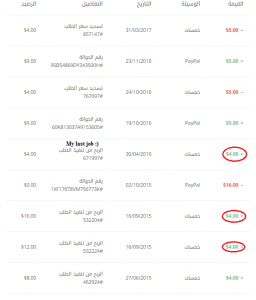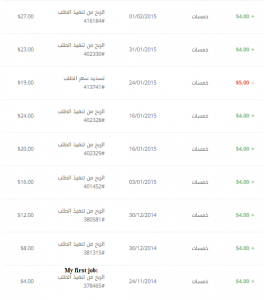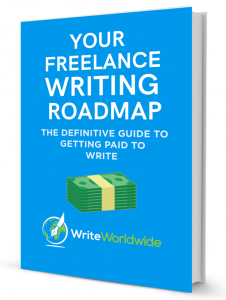No. That’s not another immigrant’s story.
And, no! I’ve never been to an “accelerated” English course.
And, I never used a pen name, and I have no plans to use one in the future.
And yet… I have been able to start a freelance writing career from nada. Zero. Nothing.
My name is Yassir Sahnoun. I’m a teenage non-native English freelance writer based in a small town near Al Hoceima, Morocco.
Following Bamidele Onibalusi’s Earn Your First $1000 as a Freelance Writer challenge, I’ve landed two well-paying clients in my first month as a freelance writer. I’ve also co-founded WriteWorldwide — a junk-free resource for non-native English writers of all levels.
My exhausting adventure was definitely not all sunshine and rainbows.
Throughout this post, I will break down all the major steps I took to reach a success many non-native English writers dream of. The good, the bad and the ugly.
Step #1: Discovering Online Entrepreneurship
Hustle is the most important word, ever.
– Gary Vaynerchuk
At the age of 13, I’ve created a habit of watching hours of YouTube tutorials made by successful Moroccan digital marketers who have built million-dollar empires working online.
This habit made me realise that making big bucks online is possible.
After watching hundreds of practical videos on how to make money online, I had to answer a question.
Which is…
What would you love to do for the rest of your life?
Certainly, my answer was: writing.
Step #2: Freelance Writing in Arabic
Berber, my native language, doesn’t have a solid presence online, meaning I should work on another language.
At the time, Arabic was the only foreign language I spoke fluently.
I started freelancing on Khamsat (what a nasty place,) an Arabic equivalent of Fiverr.
As I used to be a jack-of-all-trades, I’ve offered several services, ranging from app development to freelance writing.
Also, to build social proof, I’ve written for a couple of Arabic publications (which later helped me land my first client in the English market.)
After working for about a year and a half (from 24/11/2014 to 30/04/2016,) I’ve earned $55. Peanuts.


Simultaneously, I’ve started learning English and German in August 2015.
Step #3: Freelance Writing in English
In July 2016, after I found out about how lucrative the freelance writing world in English is, I subscribed to Writers In Charge, the first blog I really followed.
Bamidele Onibalusi, the man behind Writers In Charge, was a huge inspiration for me. Reading blog posts he wrote during his early freelance writing days convinced me that making a living writing is not rocket science.
Between July 2016 and August 2016, I’ve dedicated all of my time to hone my craft by reading high-quality content and writing a few words here and there.
No more beaches. No more snacks.
I don’t know if you’re surrounded by super fascinating beaches, but if you do, I bet you won’t resist going. Especially if they look like this one:

Quemado Beach, Al Hoceima, Morocco. Credits to The Rif Styler.
A few months after taking this decision, I stumbled upon Writers In Charge, which later launched the challenge, “Earn Your First $1000 as a Freelance Writer.”
With the help of Bamidele Onibalusi, the CEO of Writers In Charge, I’ve been able to land my first two high-paying clients, with no previous knowledge or experience.
Here’s step four of how I did it.
Step #4: Building Social Proof
One of the main pillars of the challenge was social proof. Getting a few samples of your work published on authoritative websites like The Huffington Post and Engadget is a plus.
Before hiring you, clients want to know whether you’ve got the goods – a bugbear that can only be vanished through social proof.
Bamidele Onibalusi advises writing no more than three samples for free. Make sure you write for well-reputed publications and websites that clients will recognise.
Also, establishing your personal brand through social media outlets is indispensable. Seeing the line, “No results found” popped up can be is a huge red flag for your clients.
As I was already featured on Th3 Professional, The Huffington Post Arabi and several other Arabic publications during my career in the Arabic market, social proof wasn’t a biggie.
To establish my personal brand as a freelance writer in the language learning niche, I also tried translating for a couple of non-profits and companies such as Code.org and TEDx in exchange for certifying me as an experienced translator.
With social proof set up, I was ready to move onto the next step.
Step #5: Cold Pitching
Many fellow freelance writers have created a professional website before cold pitching.
I decided not to buy a domain name as I only had $27 in my PayPal account, which I kept for Black Friday and the editor fees.
Still, setting up a website is something I highly recommend doing.
Cold pitching is simply marketing your services by sending messages to potential clients who haven’t heard about your services before.
To make the job of crafting winning cold pitches easier, Bamidele posted a few pitching templates on his blog.
Because I wasn’t aware of the templates, I tried doing something on my own…
The result was a total catastrophe:
Dear [Company Name] Team,
As I am interested in blogging for you, I would like to know the usual rate of your writers.
I write about the techniques and tools of learning languages. And specifically learning German and Arabic.
Best,
Yassir Sahnoun
(Sorry, English! I didn’t mean to hurt you at that point.)
First, I should admit that I was very lucky to get a positive response from this pitch. All freelancers admit that finances should never be directly mentioned in your cold pitch.
Here is the answer:
Hi Yassir,Thanks for your interest in [Company Name]. I’m glad you reached out, because we are currently seeking bloggers with writing experience for our blog.
Our pay rate is $70 per blog post.
To apply to become a blogger for [Company Name], please reply to me with the following information:– describe your background as it pertains to foreign languages.
– blog post samples
– 3 sample headlinesPlease let me know if you have any questions. I am looking forward to hearing from you!Best,[Editor]
Hi [editor name],I apologize for the delay, I had a technical issue that caused this.I was recently reading your FluentU article, “[Blog Post Title],” and it was enlightening. Because I recently started learning Spanish, your article was a huge inspiration for me.I especially resonated with your article as I was doing research for an article on [topic] in Spanish.I thought I should write about the same topic, but in Arabic. I attached it with this email, and it’s all ready to be published on [Company Name]!As I am speaking 6 languages, writing for FluentU was something that I always wished to do. FluentU was one of my main resources for learning German and French.I speak Berber (native language – C2), Moroccan Arabic (2nd native language – C2), Arabic (the official language of my country – C2), French (language of education- C1), German (B1) – and English, and recently started learning Spanish and Japanese.Because I am going to write in the Arabic Learner blog, here are some of my credentials:– Lead translator at Code.Org From English and German into Arabic.– Software translator at IObit Pty, Ltd. From French into Arabic– Contributor at many blogs and magazines, including TheHuffingtonPostArabi and Th3Pro.Here are 3 sample headlines:– 10 incredible apps for learning Arabic.– 100 Moroccan Arabic awesome travel words and expressions.– 5 creative ways to master writing in Arabic.I’ll appreciate your feedback, [Editor]!Best Regards,Yassir SahnounWriter, polyglot, and translator.PS. I attached my bio and PayPal address with this email.PPS. Please give me more details about your business plans for the next months, as well as how many articles you need me to write each week.
Step #6: Writing My First Blog Post
To convince my client that I’d be a good fit for their blog, I wrote a quality blog post that precisely matched their guidelines.
I printed more than ten previous blog posts from my prospect client’s blog and read them thoroughly. Meanwhile, the word count of my blog post was accumulating day by day.
But, I kept doubting myself. “What if I failed?” and, “Will I be able to handle this job if I get it?”
The idea of giving up was always in my mind, until…I met an experienced and generous editor from America – Anita Smith – who literally took my blog post from zero to hero.
Thanks to Anita, Bamidele, other group members, sweat, blood, and tears, I landed two recurring clients that still work with me in less than one month:
- A business and code blog from a list I found on Writers In Charge: $150/post
- A language learning website I used to follow: $70/post
Bottom line? Take action. It’s the only way.
Do you have any questions? Share your thoughts in the comments below.




that was an inspiring story good luck